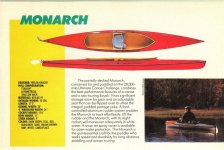-
Happy Publication of Dickens' "A Christmas Carol" (1843)! 😠👻🩼🎄
You are using an out of date browser. It may not display this or other websites correctly.
You should upgrade or use an alternative browser.
You should upgrade or use an alternative browser.
What "is" a Canoe?
- Thread starter Glenn MacGrady
- Start date
Have you received total consciousness? In the words of the Lama - "Gunga galunga... gunga, gunga-lagunga"
Not sure about the Lama and boats but I did hear that the Lama played golf - Carl Spackler said this....
"So, I'm on the first tee with him (the Lama). I give him the driver. He hauls off and whacks one - big hitter, the Lama - long, into a ten-thousand foot crevasse, right at the base of this glacier. Do you know what the Lama says? Gunga galunga... gunga, gunga-lagunga. So we finish the eighteenth and he's gonna stiff me. And I say, "Hey, Lama, hey, how about a little something, you know, for the effort, you know." And he says, "Oh, uh, there won't be any money, but when you die, on your deathbed, you will receive total consciousness." So I got that goin' for me, which is nice."
Not sure about the Lama and boats but I did hear that the Lama played golf - Carl Spackler said this....
"So, I'm on the first tee with him (the Lama). I give him the driver. He hauls off and whacks one - big hitter, the Lama - long, into a ten-thousand foot crevasse, right at the base of this glacier. Do you know what the Lama says? Gunga galunga... gunga, gunga-lagunga. So we finish the eighteenth and he's gonna stiff me. And I say, "Hey, Lama, hey, how about a little something, you know, for the effort, you know." And he says, "Oh, uh, there won't be any money, but when you die, on your deathbed, you will receive total consciousness." So I got that goin' for me, which is nice."
It's too wide to be a proper quality kevlar kayak. It was conceived for a canoe race, and it says Mad River Canoe.A question has come in from the Dalai Lama on this subject. He asks: If you are standing up in the following Mad River watercraft and propelling it with a 12 foot pole . . .
View attachment 136533
. . . are you:
(a) canoeing
(b) kayaking
(c) both
(d) neither
The Lama says only the correct answer will be divine.
Of course, if I was polling a 28" canoe it would be flotsam pretty quickly.
- Joined
- Aug 10, 2018
- Messages
- 2,048
- Reaction score
- 6,821
(e) I'm swimmingA question has come in from the Dalai Lama on this subject
I think we could have asked one of his disciples directly except Glenn blasted his recruitment thread this past winter. Darn hindsight...
um
Monarch. Sometimes double blade, mostly single and yes standing is fine.
Sea canoe. You don't visit the website Zollitsch Kayak Adventures but rather
it's a canoe because
f. You can nap in it.
Monarch. Sometimes double blade, mostly single and yes standing is fine.
Sea canoe. You don't visit the website Zollitsch Kayak Adventures but rather
it's a canoe because
f. You can nap in it.
LF Herreshoff defined a kayak as skin covered. He called his similar design in wood a "decked double paddle canoe".
Pack "canoes" seem to have pushed us into the single/double paradigm.
This issue is much older than pack canoes. John MacGregor's book from 1866 titled A Thousand Miles in the Rob Roy Canoe is generally credited with first inspiring the large scale popularity of recreational paddling. He used double bladed paddles and sails on this Rob Roy canoes as shown below. The Wikipedia link has more details. The British (and most other Europeans) still use the terms canoe and kayak interchangeably. They commonly describe our open canoes as Canadian canoes.
Benson

John MacGregor (sportsman) - Wikipedia
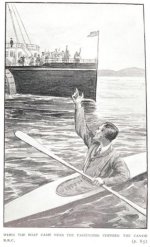
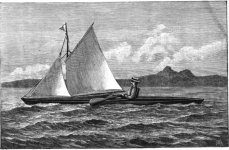
- Joined
- Oct 16, 2016
- Messages
- 41
- Reaction score
- 175
To (ab)use a metaphor from evolutionary biology, I think most of us use the term "canoe" to refer to the clade of boats descended from the birchbark canoe of northeastern North America. Of course the "evolution" and ancestry of watercraft is a little messier than that of animals, but most boats referred to as "canoes" can pretty directly trace their lineage back to birchbark canoes.
I think canoe is a worldwide concept with variations of nomenclature(UK calls them Canadian Canoes). John Jennings book "The Canoe" is a very useful read. There are many roots of "canoe". Jennings classifies them as bark, skin ,dugouts. And!!Kayaks!! His book however isNorth American centric. Dugouts are endemic in tropical areas. Presumably they were used 8000 years ago per Wiki. Birchbarks probably came along regionally as the material was available in the North, light for trade and portage and easily fixed. But the parent of all canoes, seems not. A friend of mine is studying marine archaeology in non Western areas now and has a blog. He is studying all sorts of watercraft but primarily canoes https://indigenousboats.blogspot.com/To (ab)use a metaphor from evolutionary biology, I think most of us use the term "canoe" to refer to the clade of boats descended from the birchbark canoe of northeastern North America. Of course the "evolution" and ancestry of watercraft is a little messier than that of animals, but most boats referred to as "canoes" can pretty directly trace their lineage back to birchbark canoes.
Interesting. In the first chapter of MacGregor's book he describes his decked boat, the Rob Roy, as a canoe and his canoe paddle as being "seven feet long, with a blade at each end". He manages to blur the lines quite nicely.This issue is much older than pack canoes.
I analyze the canoe-kayak-other distinction not from the noun perspective, but from primarily from the verb perspective: canoeing, kayaking, poling, power boating, sailing, portaging.
There are three ways to analyze the canoe-kayak distinction:
1. By the shape of the craft. This doesn't work because, as can be seen from the pictures in my OP and the picture of the Mad River Monarch, canoes can look exactly like kayaks or power boats or sailboats. Hence, a shape analysis is not definitive.
2. By the type of body positioning: sitting vs. kneeling vs. standing. Again, this doesn't work definitively because, although almost every kayaker sits on a bottom seat while many canoeists sit elevated or kneel, many canoeists also sit on the bottom, especially those that are in crafts that descend from the MacGregor Rob Roy, Rushton decked boat and current pack boat lineages. Some canoeists also stand, using a pole.
3. By the type of propulsion. This focus is on the propulsion verb, and overall I think it works the best as a distinction.
- propelling with single blade = canoeing
- propelling with double blade = kayaking
- propelling with pole = poling
- propelling with sail = sailing
- propelling by walking with craft on shoulders = portaging or carrying
- pushing or pulling your craft while you are dumped out in deep water = swimming
I don't think anyone flinches at saying they are poling or sailing or portaging their Chestnut Prospector, when those are the methods of propulsion used, so why should there be an objection to saying they are "kayaking" it. That's just a verbal synonym for "double blading" or "double paddling" it.
There are three ways to analyze the canoe-kayak distinction:
1. By the shape of the craft. This doesn't work because, as can be seen from the pictures in my OP and the picture of the Mad River Monarch, canoes can look exactly like kayaks or power boats or sailboats. Hence, a shape analysis is not definitive.
2. By the type of body positioning: sitting vs. kneeling vs. standing. Again, this doesn't work definitively because, although almost every kayaker sits on a bottom seat while many canoeists sit elevated or kneel, many canoeists also sit on the bottom, especially those that are in crafts that descend from the MacGregor Rob Roy, Rushton decked boat and current pack boat lineages. Some canoeists also stand, using a pole.
3. By the type of propulsion. This focus is on the propulsion verb, and overall I think it works the best as a distinction.
- propelling with single blade = canoeing
- propelling with double blade = kayaking
- propelling with pole = poling
- propelling with sail = sailing
- propelling by walking with craft on shoulders = portaging or carrying
- pushing or pulling your craft while you are dumped out in deep water = swimming
I don't think anyone flinches at saying they are poling or sailing or portaging their Chestnut Prospector, when those are the methods of propulsion used, so why should there be an objection to saying they are "kayaking" it. That's just a verbal synonym for "double blading" or "double paddling" it.
Typically there is a traditional distinction in that you are in a canoe and a kayak is worn
. Kayaks were made to fit a person.
In some ways with the evolution of the solo open canoe this became true of them also.
nowadays the plastic tubs with pointy ends that have a L/W ratio of 2:1 rather than 7:1 are neither kayak or canoe and are banned from the Allagash
Yes your boat gas to fit size limits
. Kayaks were made to fit a person.
In some ways with the evolution of the solo open canoe this became true of them also.
nowadays the plastic tubs with pointy ends that have a L/W ratio of 2:1 rather than 7:1 are neither kayak or canoe and are banned from the Allagash
Yes your boat gas to fit size limits
In 1886 when MacGregor wrote his book it is possible that the word "kayak" may have only been used by the Arctic People and not been a part of the English language. Just a guess.
In 1886 when MacGregor wrote his book it is possible that the word "kayak" may have only been used by the Arctic People and not been a part of the English language. Just a guess.
The Oxford English Dictionary shown below indicates that kayak first entered the language in the 1660s to describe Eskimo boats. Most of the examples seem to indicate that canoe was considered a synonym. Their definition of canoe is also shown for comparison.
Benson
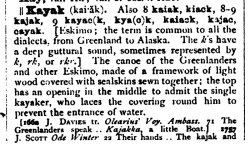
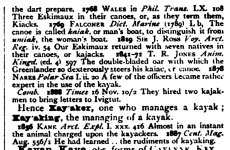
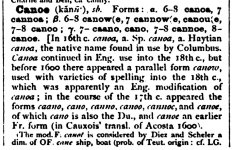
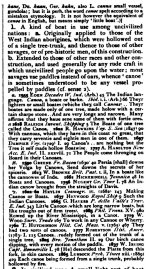
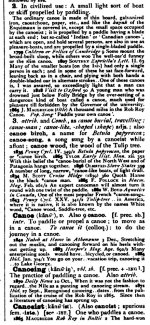
Last edited:
That makes sense. I wonder if there's a sketch or written description of a "kayak" being paddled with a single blade paddle?The Oxford English Dictionary shown below indicates that kayak first entered the language in the 1660s to describe Eskimo boats. Most of the examples seem to indicate that canoe was considered a synonym.
I wonder if there's a sketch or written description of a "kayak" being paddled with a single blade paddle?
There is a picture as shown at the link below.
Benson

Iñupiat in kayak, Nome, Alaska, between 1905 and 1915
Caption on image: Eskimo in Kiak. - Nome, Alaska - Lomen Bros - PH Coll 413.Album 12.33a
Last edited:
Perfect. A photo of a canoeist.There is a picture as shown at the link below.
this addresses the question of "What is canoe-ing/kayak-ing."I analyze the canoe-kayak-other distinction not from the noun perspective, but from primarily from the verb perspective: canoeing, kayaking, poling, power boating, sailing, portaging.
Different from the original question of "What is A canoe."
Have we asked the Monarch what it identifies as?
The "canoe" has been subject to interpretations applied across cultures and continents, and has been reinterpreted/reinvented/redesigned ever since the first western European "discovered it". The words we've used to describe this craft have changed.
To answer your question Glenn, the Monarch is precisely a kayak but broadly a canoe. And why not? Canoe has had either a wide or narrow meaning depending on which imperfect definition you dip into. People can label it whichever to suit their own particular lifestyle plans.
What is a canoe to me? It is a paddlecraft that resembles in form and function the Ojibwe birch bark canoes. Why? Because in my bias that is the most perfect construction of ingenuity, economy, and art. Modernizations have been attempting to match that perfection ever since and have flooded us consumers with exquisite designs ever since. It would be difficult not to have a collection of canoes budget permitting. And if the Monarch slipped into that definition perhaps one of those too.
As for the Monarch kayak world based on sof craft of the most northern latitudes, that's a whole other world worth enjoying too.
The thin edge of the wedge alluded to here in this thread is the canoe in canoe tripping and how that can be defined for the sake of this website forum. That's a debate/discussion I have little interest in. Some words lose their meaning over time.
To answer your question Glenn, the Monarch is precisely a kayak but broadly a canoe. And why not? Canoe has had either a wide or narrow meaning depending on which imperfect definition you dip into. People can label it whichever to suit their own particular lifestyle plans.
What is a canoe to me? It is a paddlecraft that resembles in form and function the Ojibwe birch bark canoes. Why? Because in my bias that is the most perfect construction of ingenuity, economy, and art. Modernizations have been attempting to match that perfection ever since and have flooded us consumers with exquisite designs ever since. It would be difficult not to have a collection of canoes budget permitting. And if the Monarch slipped into that definition perhaps one of those too.
As for the Monarch kayak world based on sof craft of the most northern latitudes, that's a whole other world worth enjoying too.
The thin edge of the wedge alluded to here in this thread is the canoe in canoe tripping and how that can be defined for the sake of this website forum. That's a debate/discussion I have little interest in. Some words lose their meaning over time.
Last edited:
Similar threads
- Replies
- 235
- Views
- 44K
- Replies
- 9
- Views
- 3K
- Replies
- 53
- Views
- 11K

